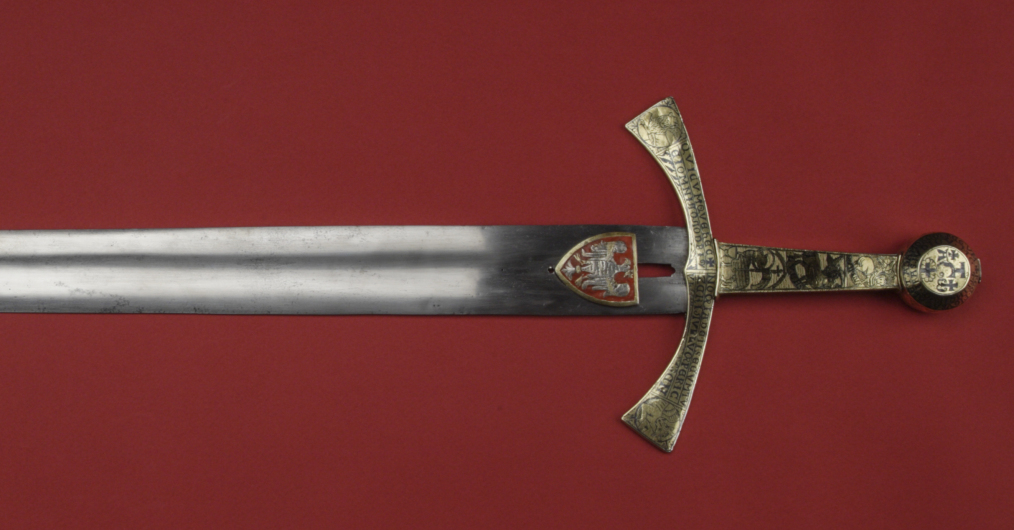DECEMBER 24, 25 THE CASTLE IS CLOSED | Wawel tickets official site: bilety.wawel.krakow.pl
Military objects
One of the most valuable Polish collections of antique weapons, from the 13th to the 17th century
The militaria department contains over 1000 pieces of various types of offensive and defensive weapons and army equipment. Objects recovered from the USSR following the treaty of Riga of 1921 and Cieszyn’s Bruno Konczakowski’s great collection, bought after his death in 1961 are at the core of the collection. Private donations and purchases made by the Royal Castle should not be overlooked. The core collection contains weapons from the 13th to 18th c, but there are also single earlier exhibits (a Greek hoplite’s helmet, a sword from the Hallstatt period) and a large set of 19th c. weaponry. The most valuable exhibit in the collection is a splendid coronation sword named Szczerbiec, the only existing insignium from the regalia collection, kept in the Royal Treasury until 1795. Medieval and Renaissance objects constitute a small but important category. Noteworthy examples include a suit of late Gothic tournament armour, and various beautiful helmets (a Hundsgugel helmet from the beginning of the 15th c, a sallet from the end of the 15th c., and 16th-c beavers and basinets).
However, the greatest significance is given to weapons from the 17th and 18th c., including many related to Polish monarchs, hetmans or representatives of senators’ families. There are Hussar half-suits (including a unique exhibit with its original wings), suits of scale armour, sabres, estocks, batons and maces. Splendid horse livery and saddles are particularly noteworthy. Some of them were made in Poland, some in the East – in Turkey and Persia. Among the latter there are trophies won during the Turkish-Polish wars, and also during the Vienna campaign in 1683. Hand firearms (pistols, arquebuses, muskets and rifles) and cold steel (rapiers and swords) of high artistic value were mostly made in leading western European workshops.
Among shaft weapons there are partisans used by Polish kings’ soldiers (John Casimir, Michal Korybut Wiśniowiecki, John III Sobieski, Augustus II the Strong and Augustus III the Saxon. Another collection includes canons, howitzers and mortars from the 16th -18th c., and is one of the best in Poland (on a par with the Polish Army Museum collection).
Militaria is exhibited in rooms on the ground floor of the castle, within the Castle Armoury and the Royal Treasury. A large collection of weapons is also exhibited in the oriental treasure exhibition on the first floor of the western wing of the castle.
However, the greatest significance is given to weapons from the 17th and 18th c., including many related to Polish monarchs, hetmans or representatives of senators’ families. There are Hussar half-suits (including a unique exhibit with its original wings), suits of scale armour, sabres, estocks, batons and maces. Splendid horse livery and saddles are particularly noteworthy. Some of them were made in Poland, some in the East – in Turkey and Persia. Among the latter there are trophies won during the Turkish-Polish wars, and also during the Vienna campaign in 1683. Hand firearms (pistols, arquebuses, muskets and rifles) and cold steel (rapiers and swords) of high artistic value were mostly made in leading western European workshops.
Among shaft weapons there are partisans used by Polish kings’ soldiers (John Casimir, Michal Korybut Wiśniowiecki, John III Sobieski, Augustus II the Strong and Augustus III the Saxon. Another collection includes canons, howitzers and mortars from the 16th -18th c., and is one of the best in Poland (on a par with the Polish Army Museum collection).
Militaria is exhibited in rooms on the ground floor of the castle, within the Castle Armoury and the Royal Treasury. A large collection of weapons is also exhibited in the oriental treasure exhibition on the first floor of the western wing of the castle.
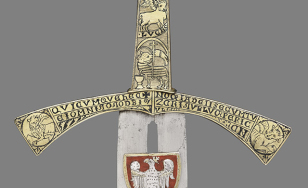 SZCZERBIEC – coronation sword of Polish kings, Rhineland (?), 2nd quarter of the 13th c.
SZCZERBIEC – coronation sword of Polish kings, Rhineland (?), 2nd quarter of the 13th c.
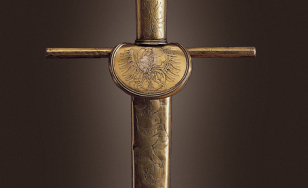 KING SIGISMUND I THE OLD’S SWORD. Kraków, c. 1520
KING SIGISMUND I THE OLD’S SWORD. Kraków, c. 1520
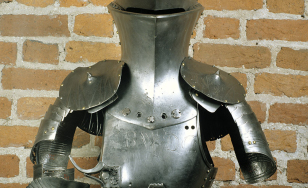 TOURNAMENT ARMOUR. Nuremberg, Konrad Poler, c. 1490
TOURNAMENT ARMOUR. Nuremberg, Konrad Poler, c. 1490
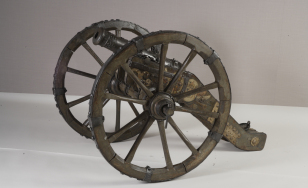 CANNON WITH AN EMBLEM OF HERCULES. Nuremberg, Oswald Baldner, mid 16th c. (with later gun carriage)
CANNON WITH AN EMBLEM OF HERCULES. Nuremberg, Oswald Baldner, mid 16th c. (with later gun carriage)
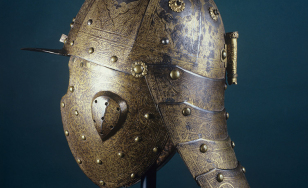 BASINET. Southern Germany, 2nd half of the 16th c.
BASINET. Southern Germany, 2nd half of the 16th c.
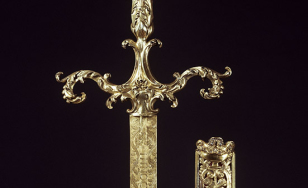 CONSECRATED SWORD. Rome, 1675-76
CONSECRATED SWORD. Rome, 1675-76
 SADDLE FROM SULTAN MUSTAFA II’s GIFT. Turkey, 3rd quarter of the 17th c.
SADDLE FROM SULTAN MUSTAFA II’s GIFT. Turkey, 3rd quarter of the 17th c.
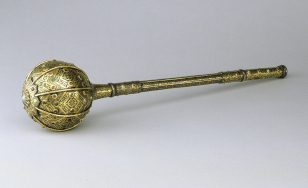 BATON. Poland, 2nd half of the 17th c.
BATON. Poland, 2nd half of the 17th c.
SZCZERBIEC – coronation sword of Polish kings

Rhineland (?), 2nd quarter of the 13th c.
Steel blade and gold hilt, decorated in the niella technique. Originally the property of prince
Boleslaus (perhaps Boleslaus Konradowic or Boleslaus the Pious) as the inscription on the
hilt (no longer visible) indicated. At the time it probably functioned as a symbol of
legislative power (gladius iustitiae). In 1320 it was used in Wawel Cathedral as the
coronation sword by Ladislaus the Short. After that time it was kept with the other regalia
in the Crown Treasury at Wawel, from where it was looted by the Prussians in 1795. It
subsequently went through the hands of different collectors: around 1810 it was in Dymitr Łabanov-
Rostowski’s collection, in 1818 he offered it to general Wincenty Krasiński in Warsaw; before 1843 it was
sold to prince Anatol Demidovov from San Donato near Florence, and from 1870 it was in A.P. Bazylewski’s
possession in Paris. In 1884 it was bought for the Hermitage in St. Petersburg, from where it was
recovered through exchange and transferred to Wawel. One of the most valuable medieval ceremonial
swords in Europe, it is one of the most important symbols of Polish state sovereignty.
Steel blade and gold hilt, decorated in the niella technique. Originally the property of prince
Boleslaus (perhaps Boleslaus Konradowic or Boleslaus the Pious) as the inscription on the
hilt (no longer visible) indicated. At the time it probably functioned as a symbol of
legislative power (gladius iustitiae). In 1320 it was used in Wawel Cathedral as the
coronation sword by Ladislaus the Short. After that time it was kept with the other regalia
in the Crown Treasury at Wawel, from where it was looted by the Prussians in 1795. It
subsequently went through the hands of different collectors: around 1810 it was in Dymitr Łabanov-
Rostowski’s collection, in 1818 he offered it to general Wincenty Krasiński in Warsaw; before 1843 it was
sold to prince Anatol Demidovov from San Donato near Florence, and from 1870 it was in A.P. Bazylewski’s
possession in Paris. In 1884 it was bought for the Hermitage in St. Petersburg, from where it was
recovered through exchange and transferred to Wawel. One of the most valuable medieval ceremonial
swords in Europe, it is one of the most important symbols of Polish state sovereignty.
Armour of the Teenage King Sigismund II Augustus

This late medieval and Renaissance suit of armor served a practical purpose, yet it was also symbolic and for show. This was a most costly bit of apparel.
King Sigismund II Augustus’s suit is an outstanding example of armor being forged to resemble court garb. The steel plates were wrought in the manner of a suit of soft cloth, stitched (cut?) to a slanted grate, filled with four-leaf designs. This geometrical decoration, rounded off with grasses and gilded flora ornaments, contrasts with the smooth, polished background.
Of all the armaments of Sigismund II Augustus, apart from the ones of his youth presented here, only a full rider’s apparel made by Kunz Lochner in Nuremberg has survived, gifted to King John III of Sweden on the occasion of his nuptials with Catherine Jagiellon (now stored at the Royal Armory in Stockholm).
By the authority of a decision by the arbitrations court in 1933, the armor was handed over from the imperial Viennese collections to the National Museum in Budapest, as allegedly the property of Hungarian King Louis II, who perished in battle with the Turks at the Battle of Mohács in 1526.
In reality, as outstanding weapons expert Bruno Thomas showed in 1939, the armor was ordered in 1533 by the king of Czechia and Hungary (later the emperor) Ferdinand I for the nuptials of his daughter Elizabeth with the son of Sigismund I, the thirteen-year-old Sigismund II Augustus, crowned King of Poland in his father’s lifetime. The breastplate and sleeves hold an interlocking monogram with the letters "E" and "S" (Elisabetha, Sigismundus).
3D model of the armour
The scan was prepared by the company Tripiodi Sebastian Michałowski
Preparation of the armour for the scan - The team of the Artistic Crafts Conservation Workshop: Jan Kostecki, Daniel Bednarczyk, Tadeusz Galant, Maria Kisiel-Jarek, Magdalena Otłowska
Coordination: Kama Guzik, Zuzanna Tomczyk
The project was realised in partnership with the Adam Mickiewicz Institute.
Preparation of the armour for the scan - The team of the Artistic Crafts Conservation Workshop: Jan Kostecki, Daniel Bednarczyk, Tadeusz Galant, Maria Kisiel-Jarek, Magdalena Otłowska
Coordination: Kama Guzik, Zuzanna Tomczyk
The project was realised in partnership with the Adam Mickiewicz Institute.
3D model
LOG IN
REGISTRATION
